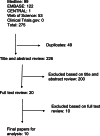3D - Printed Patient Specific Instrumentation in Corrective Osteotomy of the Femur and Pelvis: A Review of the Literature
- PMID: 33170384
- PMCID: PMC7653713
- DOI: 10.1186/s41205-020-00087-0
3D - Printed Patient Specific Instrumentation in Corrective Osteotomy of the Femur and Pelvis: A Review of the Literature
Abstract
Background: The paediatric patient population has considerable variation in anatomy. The use of Computed Tomography (CT)-based digital models to design three-dimensionally printed patient specific instrumentation (PSI) has recently been applied for correction of deformity in orthopedic surgery. This review sought to determine the existing application of this technology currently in use within paediatric orthopaedics, and assess the potential benefits that this may provide to patients and surgeons.
Methods: A review was performed of MEDLINE, EMBASE, and CENTRAL for published literature, as well as Web of Science and clinicaltrials.gov for grey literature. The search strategy revolved around the research question: "What is the clinical impact of using 3D printed PSI for proximal femoral or pelvic osteotomy in paediatric orthopaedics?" Two reviewers, using predetermined inclusion criteria, independently performed title and abstract review in order to select articles for full text review. Data extracted included effect on operating time and intraoperative image use, as well as osteotomy and screw positioning accuracy. Data were combined in a narrative synthesis; meta-analysis was not performed given the diversity of study designs and interventions.
Results: In total, ten studies were included: six case control studies, three case series and a case report. Five studies directly compared operating time using PSI to conventional techniques, with two showing a significant decrease in the number of intraoperative images and operative time. Eight studies reported improved accuracy in executing the surgical plan compared to conventional methods.
Conclusion: Compared to conventional methods of performing femoral or pelvic osteotomy, use of PSI has led to improved accuracy and precision, decreased procedure times, and decreased intra-operative imaging requirements. Additionally, the technology has become more cost effective and accessible since its initial inception and use.
Keywords: 3D printing; Femoral osteotomy; Orthopaedic surgery; Patient specific instrumentation; Pelvic osteotomy.
Conflict of interest statement
KM has received research support from Allergan, Pega Medical and Depuy Synthes (Johnson & Johnson). None are directly relevant to the research in this paper. For the remaining authors none were declared.
Figures
Similar articles
-
Three-dimensional printing in paediatric orthopaedic surgery.World J Orthop. 2022 Jan 18;13(1):1-10. doi: 10.5312/wjo.v13.i1.1. eCollection 2022 Jan 18. World J Orthop. 2022. PMID: 35096533 Free PMC article.
-
The effect of three-dimensional (3D) printing on quantitative and qualitative outcomes in paediatric orthopaedic osteotomies: a systematic review.EFORT Open Rev. 2021 Feb 1;6(2):130-138. doi: 10.1302/2058-5241.6.200092. eCollection 2021 Feb. EFORT Open Rev. 2021. PMID: 33828856 Free PMC article. Review.
-
Tumor resection at the pelvis using three-dimensional planning and patient-specific instruments: a case series.World J Surg Oncol. 2016 Sep 21;14(1):249. doi: 10.1186/s12957-016-1006-2. World J Surg Oncol. 2016. PMID: 27729037 Free PMC article.
-
Clinical Study of 3D Imaging and 3D Printing Technique for Patient-Specific Instrumentation in Total Knee Arthroplasty.J Knee Surg. 2017 Oct;30(8):822-828. doi: 10.1055/s-0036-1597980. Epub 2017 Jan 25. J Knee Surg. 2017. PMID: 28122388
-
The Use of 3D Printing as an Educational Tool in Orthopaedics.JB JS Open Access. 2025 May 29;10(2):e25.00062. doi: 10.2106/JBJS.OA.25.00062. eCollection 2025 Apr-Jun. JB JS Open Access. 2025. PMID: 40443444 Free PMC article. Review.
Cited by
-
3D Printing Technology in Pediatric Orthopedics: a Primer for the Clinician.Curr Rev Musculoskelet Med. 2023 Sep;16(9):398-409. doi: 10.1007/s12178-023-09847-x. Epub 2023 Jun 19. Curr Rev Musculoskelet Med. 2023. PMID: 37335502 Free PMC article. Review.
-
Effects of femoral de-rotation on lower limb alignment using patient-specific guides with reliance on EOS scan, a retrospective study.J Orthop Surg Res. 2025 Apr 12;20(1):371. doi: 10.1186/s13018-025-05774-4. J Orthop Surg Res. 2025. PMID: 40221750 Free PMC article.
-
Three-dimensional printing in paediatric orthopaedic surgery.World J Orthop. 2022 Jan 18;13(1):1-10. doi: 10.5312/wjo.v13.i1.1. eCollection 2022 Jan 18. World J Orthop. 2022. PMID: 35096533 Free PMC article.
-
Correction of complex three-dimensional deformities at the proximal femur using indirect reduction with angle blade plate and patient-specific instruments: a technical note.J Orthop Surg Res. 2021 Jul 3;16(1):427. doi: 10.1186/s13018-021-02579-z. J Orthop Surg Res. 2021. PMID: 34217344 Free PMC article.
-
Computer-Aided Design and 3D Printing of Hemipelvic Endoprosthesis for Personalized Limb-Salvage Reconstruction after Periacetabular Tumor Resection.Bioengineering (Basel). 2022 Aug 18;9(8):400. doi: 10.3390/bioengineering9080400. Bioengineering (Basel). 2022. PMID: 36004925 Free PMC article.
References
-
- OCEBM Levels of Evidence Working Group (2018) “The Oxford levels of evidence 2”. Oxford Centre for Evidence-Based Medicine. https://www.cebm.net/index.aspx?o=5653. Accessed 18 Apr 2018.
Publication types
LinkOut - more resources
Full Text Sources

